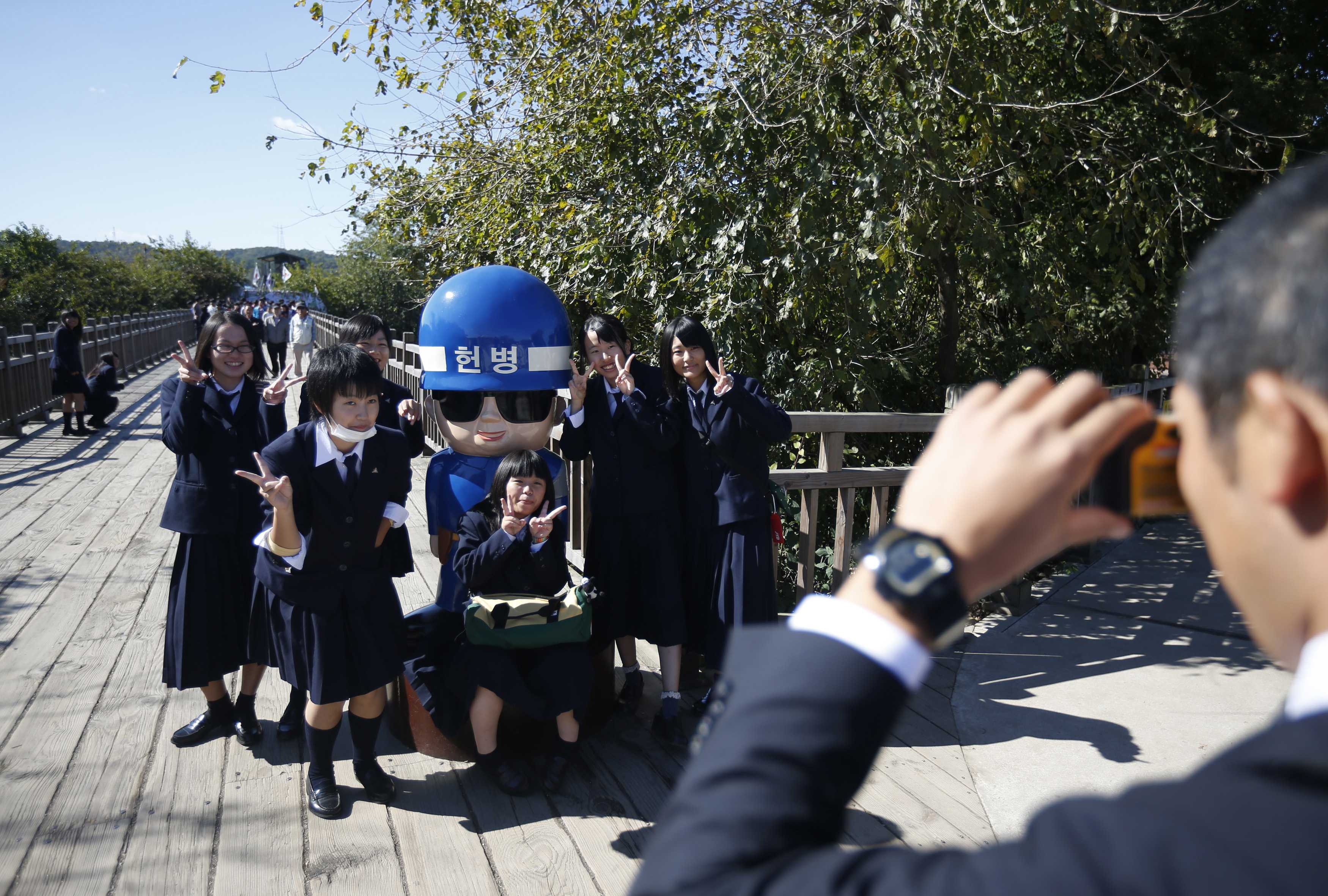DEMILITARISED ZONE, South Korea – South Korean soldiers are everywhere on the south side of the misleadingly named Demilitarised Zone. They guard buildings and man roadblocks to keep the invading hordes at bay.
Today the hordes aren't North Korean soldiers. They're tourists.
With the Berlin Wall and the Soviet Union gone, tourists now flock to both sides of the DMZ, the world's most heavily armed border, established 60 years ago. But what they see is more likely to be tacky than terrifying.
On the south side, souvenir shops sell DMZ T-shirts, DMZ-branded chocolates, DMZ baseball caps and pieces of "authentic" DMZ barbed wire mounted on ceramic tiles. Others sell dusty bottles of North Korean alcohol and miniature combat uniforms.
"The middle-aged tourists that come here like buying the clothes for their kids," Cho Hyang Hwa, an ethnic Korean Chinese citizen working at the shop, told Reuters.
Not far from barbed wire fences and rifle-wielding soldiers, children scream in delight while riding in a huge ship that swings back and forth on a giant pendulum.
The ride is named, with no apparent sense of place, the Super Viking. It serves as the flagship of Peace Land, a small and surreal theme park that looks onto rolling North Korean mountain ranges.
The loud pop music that accompanies the Super Viking is drowned out only by the occasional U.S. military helicopter that buzzes overhead before disappearing behind the tree tops.
Nearby, workers were erecting a giant statue of a ginseng plant woven from hemp for a festival devoted to the popular root. The DMZ's soil is said to yield Korea's finest ginseng.
"I'm surprised to see how different the atmosphere is from what I expected," said Park Kyung-doo, a South Korean schoolgirl. "It's good for the tourists but, as a person who came to see and learn about North Korea, I don't really feel satisfied."
Cold war divide
Tourism also exists on the DMZ's north side but is more muted. One attraction is Peace Village, a Potemkin-like place of empty buildings nicknamed Propaganda Village in the south.
Its major landmark is a 160-metre (175-yard) flagpole that deliberately tops the one in Freedom Village, a small town on the South Korean side of the zone.
The DMZ, which snakes for 240 km (150 miles) along the 38th parallel, was drawn in the 1953 armistice that ended three years of bitter fighting but left the two Koreas in a technical state of war that still exists.
The zone is 4 km wide, with the most visited area an hour's drive north of Seoul - the capital of a global economic powerhouse exporting cars, ships, semiconductors, high-tech devices, steel and petrochemicals.
The North, which once held an economic lead over the South, exports other stuff: drugs, nuclear arms and counterfeit cash.
For decades after the armistice, DMZ tourism was largely reserved to VIPs in the North and South. North Korea opened its side to Western tourists in the early 1990s. The South stepped up DMZ tourism in 2002 when Paju, a city bordering the zone, started promoting tourism to boost the local economy.
In the zone's alphabet-soup terminology, the actual border is called the MDL, or Military Demarcation Line. The area inside the DMZ and closest to the MDL is the Joint Security Area, or JSA.
Visitors should book tours - and bring their passports - instead of driving to the DMZ on their own. A wrong turn could land you in trouble. Ask in advance where the tour will go because some DMZ attractions are better than others.
The best thing, by far, is to stand with one foot in each Korea and straddle the Cold War divide - possible only in one of the JSA's blue United Nations huts, where a polished wooden table crosses the border. Often, those sitting at the table are tourists instead of North and South Korean negotiators.
Despite the carnival atmosphere, visiting the DMZ can feel tense at times. In September, South Korean soldiers shot and killed a man who made a rare attempt to enter North Korea by floating across a river that abuts the zone.
Everyday rules forbid flip-flops and brightly coloured hair in the JSA. Pointing, shouting or gesturing towards the North is strictly prohibited and U.S. troops ask tourists to sign liability waivers in case of mishaps.
Tunnels and propaganda
On the North side, the mood is oddly relaxed. Here, flip flops and blue hair are tolerated - for tourists, anyway. Visitors must organise themselves into neat lines before entering the JSA, where North Korean officers deliver a well-rehearsed presentation on North-South relations.
The presentation continues in an off-site hut used to sign the original armistice. Here, visitors "learn" it was the South that started the 1950-53 war and hear hyperbole about the "unstoppable might" of the Korean People's Army.
The South's story is different but only slightly less strident.
"I just came from the observatory where they had a truthful but unbelievably propagandistic video presentation," said David Welch, a Canadian security specialist visiting Seoul. "It's understandable, passions are still high, but I think propaganda is more effective when it's not quite so in your face."
Another top attraction is Tunnel No. 3, one of four passages dug beneath the DMZ by the North and discovered by the South. Tourists don hard hats and descend into the tight, claustrophobic confines. The climb back up can be arduous.
There is also a mountain-top observation post with coin-operated spyglasses for staring into the North. Pictures are allowed only from a line well back of the viewing area.
DMZ tourism dropped slightly during military tensions earlier this year but has since rebounded. Tourists come from everywhere: America, Europe and all around Asia.
"Does it feel dangerous? No way!" said Xin Qin, a 25-year-old from Sichuan, China. "Am I nervous? No. Just curious.





















































